
Does your lawn mower struggle with those tight corners and hard-to-reach places? A weed eater can help fix those imperfections. But with so many brands, designs, and power sources to choose from, which weed eater is the right tool for you?
We did the hard part for you. We scouted the market, searched high and low, and rounded up 10 of the best weed eaters fit for the job.
So how did we compare the best weed trimmers? We ranked each tool in five categories, taking a weighted average of each rank:
- Cost: 10%
- Weight: 15%
- Cutting Swath: 25%
- Line Diameter: 20%
- Engine / Revolutions Per Minute: 30%
Below you’ll find the top 10 weed eaters with the best-weighted averages. We’ve also added a buyers guide on how to find the right weed eater for you and your yard. The rest is in your hands!
1. (tie) Husqvarna 128LD
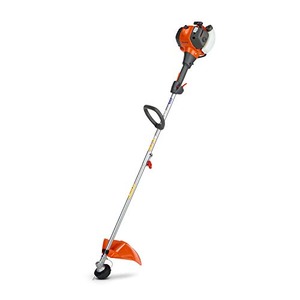
(tie) Husqvarna 128LD
The best selling 128LD is your go to gas trimmer when you need a powerful and easy to use tool for grass, weeds and more.
Users rave over the Husqvarna 128LD’s weed-eating power. With a 17-inch cutting path, 28 cc engine, straight shaft design, and 0.095-inch thick trimmer line, power should come as no surprise with this weed-eating monster.
Don’t worry about stopping your work to restock this tool’s trimmer line. The Husqvarna 128LD boasts a Tap ‘N Go line release feature. Give the trimmer head a quick tap when the line is running low, and you’ll be on your way.
And did we mention this tool is more than just a weed eater? The Husqvarna 128LD is compatible with three separate “click-on” attachments: edger, pole saw, and cultivator. Tackle multiple jobs at once while saving space in your tool shed.
Specifications:
- Weight: 12.7 lbs
- Cutting Swath: 17 inches
- Line Diameter: 0.095 inches
- Engine: 28 cc
Pros:
✓ 17-inch cutting path
✓ Compatible with 0.095-inch thick trimmer line
✓ Tap ‘N Go line release feature
✓ Powerful engine
✓ Straight shaft design means more power and better access to hard-to-reach areas
✓ Compatible with three “click-on” attachments: edger, pole saw, and cultivator
✓ Lightweight relative to other gas models
✓ Engine is designed for quick starts with minimal effort
✓ Users report the trimmer line is easy to reload
Cons:
✗ Tall users report the weed eater has poor ergonomics, making it uncomfortable to operate.
✗ Expensive
2. (tie) Poulan Pro PR28SD
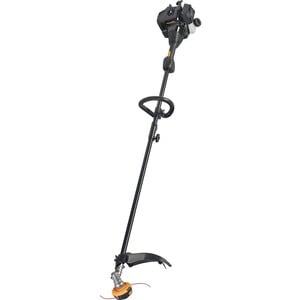
(tie) Poulan Pro PR28SD
Poulan Pro trimmers boast features that ensure there’s a unit that’s perfect for every job.
The Poulan Pro PR28SD tied for first place with the Husqvarna 128LD. Both weed eaters have a 17-inch cutting swath, straight shaft design, 28 cc engine, and 0.095-inch thick trimmer line.
So what sets these tools apart?
The Poulan Pro PR28SD is 1 pound heavier than the Husqvarna 128LD, so you might run into more user fatigue with this weed eater. On the other hand, the Poulan Pro is less expensive than the Husqvarna (though this is subject to change).
This Poulan Pro weed whacker is compatible with six separate trimmer attachments so you can get more work done with one tool. These attachments include an edger, blower, pole saw, hedge trimmer, brush cutter, and cultivator.
Operators praise the Poulan Pro PR28SD for its effortless startups. The gas string trimmer comes equipped with a spring-assisted starter system so you don’t have to lose all your energy before you even begin.
Specifications:
- Weight: 14 lbs
- Cutting Swath: 17 inches
- Line Diameter: 0.095 inches
- Engine: 28 cc
Pros:
✓ 17-inch cutting path
✓ Compatible with 0.095-inch thick trimmer line
✓ Powerful engine
✓ Dual-line bump feed system
✓ Reloading trimmer line is quick and easy
✓ Spring-assisted starter system for effortless starting
✓ Straight shaft design means more power and better access to hard-to-reach areas
✓ Compatible with six trimmer attachments: edger, blower, pole saw, hedge trimmer, brush cutter, and cultivator
Cons:
✗ 14 lbs may be too heavy for some operators
✗ Some users report the tool failed after only a few uses
✗ Expensive
3. Craftsman CMXGTAMD30SA
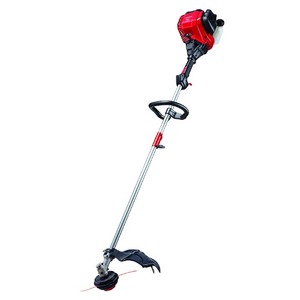
Craftsman CMXGTAMD30SA
Make yard clean-up easy with the Craftsman CMXGTAMD30SA 4-Cycle Gas Powered String Trimmer.
The Craftsman CMXGTAMD30SA shows off the most powerful gas engine on our list. With a 30 cc engine, 17-inch cutting path, and 0.095-inch thick trimmer feed, this weed eater will get the toughest jobs done fast.
Little will stand in the way of this powerful straight-shaft string trimmer and its easy startup system. Satisfied users praise the Craftsman for its 4-cycle engine, as it doesn’t require mixing oil and gas. The string trimmer also holds up to 20 feet of trimmer line and has a bump feed system.
Last but not least, this weed eater was designed with noise reduction in mind and features a multi-position handle made to reduce vibrations and muscle fatigue.
Specifications:
- Weight: 14.6 lbs
- Cutting Swath: 17 inches
- Line Diameter: 0.095 inches
- Engine: 30 cc
Pros:
✓ Powerful 30 cc engine
✓ 17-inch cutting path
✓ Compatible with 0.095-inch thick trimmer line
✓ Straight shaft design means more power and better access to hard-to-reach areas
✓ The 4-cycle engine doesn’t require mixing oil and gas
✓ Holds up to 20 feet of trimmer line
✓ The tool’s design is intended to reduce noise and vibrations
✓ Compatible with multiple yard tool attachments
Cons:
✗ Some users report the tool is too heavy
✗ Expensive
4. Craftsman WS205
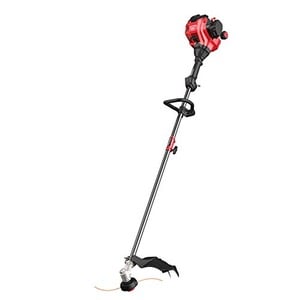
Craftsman WS205
The CRAFTSMAN WS2200 gas powered WEEDWACKER trimmer features a 25cc 2-cycle engine that is lightweight and easy to use.
Interested in a user-friendly, lightweight gas weed eater? Check out the Craftsman WS205. Users report the weed eater is easy to assemble, maneuverable, and gets the job done with ease.
The tool’s straight shaft design means you get horsepower and durability, more than you would find in most curved shaft models. The bump-feed system reloads the trimmer line on command so you don’t have to pause your work and reload the line yourself.
The Craftsman WS205 also features an easy 3-step starting system, multi-position handle, and is compatible with multiple tool attachments.
Specifications:
- Weight: 13 lbs
- Cutting Swath: 17 inches
- Line Diameter: 0.095 inches
- Engine: 25 cc
Pros:
✓ Lightweight design relative to other gas models
✓ 17-inch cutting path
✓ 0.095-inch thick line diameter
✓ Straight shaft system
✓ Easy 3-step startup system
✓ Consumers report the tool is user-friendly
Cons:
✗ Users report poor customer service
✗ Lowest engine cc compared to the other gas weed eaters on this list
3 Top Battery-Powered Weed Eaters – Reviews
| 1. WORX WG191 |
| 2. Craftsman CMCST910M1 |
| 3. Scotts Outdoor Power Tools LST02012S |
Despite the incredible power, sometimes operating a gas-powered machine isn’t all that it’s cracked up to be. Gas tools emit harmful and smelly exhaust fumes, and they can be too heavy for some users to operate. That’s why battery-powered tools are growing in popularity.
1. WORX WG191
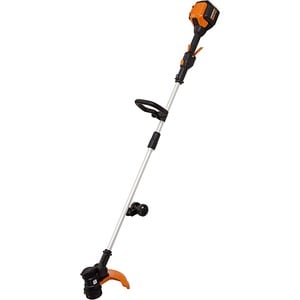
WORX WG191
The WORX WG191 56V Max Li-Ion 13-Inch Cordless Grass Trimmer features a new Command FeedTM system that allows instant trimmer line advancing – no more bumping or waiting for the line to advance before cutting.
The first battery weed eater you’ll want to check out is the WORX WG191. It’s packed with incredible power at 8300 revolutions per minute (rpm) and a 0.08-inch thick trimmer line. Users say their WORX WG191 tackles weeds and brush without a hitch.
The string trimmer also has convenient features to boot. Tired of damaging your trimmer head with a bump feed system or relying on an auto-feed system’s guesswork? The WORX WG191 boasts a command feed spool system, restocking your trimmer line at the click of a button and putting you in full control.
Features we liked: This weed eater also has:
- Variable speed control so you can increase battery run time
- A rotating rear handle for maximum comfort
- Convenient conversion from a trimmer to a wheeled edger
- A trimmer head that pivots from 0 to 90 degrees
- A power battery indicator that shows the remaining battery life.
Specifications:
- Weight: 8.8 lbs
- Cutting Swath: 13 inches
- Line Diameter: 0.08 inches
- Revolutions Per Minute: 8300 rpm
Pros:
✓ Compared to other non-gas models, the WORX WG191 has the highest rpm
✓ Lightweight design compared to gas weed eaters
✓ Variable speed control delivers longer battery run time
✓ Command feed spool system
✓ Rotating rear handle for maximum comfort
✓ Converts from a trimmer to a wheeled edger
✓ Trimmer head pivots from 0 to 90 degrees to provide the best angle for the job
✓ Power battery indicator shows the remaining battery life
Cons:
✗ Heaviest non-gas model on our list
✗ 13-inch cutting path may not be large enough for some users
✗ Expensive
2. Craftsman CMCST910M1
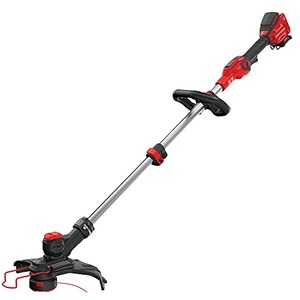
Craftsman CMCST910M1
The Craftsman CMCST910M1 weed eater is significantly less expensive than the WORX WG191, weighs only 6.3 pounds, and is powered by a 20-volt lithium-ion battery.
The Craftsman CMCST910M1 weed eater is powered by a 20-volt lithium-ion battery, weighs only 6.3 pounds and is priced much lower than the WORX WG191.
It also has an on-demand string system at the click of a button, a two-speed control system to extend battery life, and a convenient VERSATRACK hook compatible with the VERSATRACK Wall Organization System (sold separately).
Need to edge around the flower beds? Convert this crafty weed eater into an edger with ease.
Satisfied operators praise this weed eater’s impressive battery life, good balance, and increased user comfort with the adjustable shaft.
Specifications:
- Weight: 6.3 lbs
- Cutting Swath: 13 inches
- Line Diameter: 0.08 inches
- Revolutions Per Minute: 7200 rpm
Pros:
✓ 0.08-thick trimmer line
✓ Lightweight design
✓ Users report impressive battery life
✓ Adjustable straight shaft enhances comfort
✓ Command feed spool system
✓ Two-speed control system for extended battery life
✓ VERSATRACK hook compatible with the VERSATRACK Wall Organization System (sold separately)
✓ Converts into an edger
Cons:
✗ Edger is not guided by a wheel
✗ Some users describe a poor experience with the line feed system
✗ Expensive
3. Scotts Outdoor Power Tools LST02012S
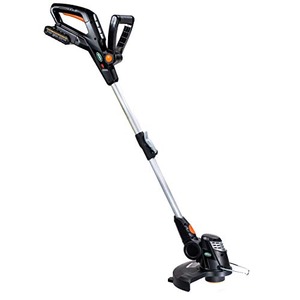
Scotts Outdoor Power Tools LST02012S
The Scotts 20-volt cordless string trimmer is the best lawn trimmer users can buy without breaking the bank.
A lightweight and comfortable weed eater? The Scotts Outdoor Power Tools LST02012S weighs only 5 pounds — the lightest weed eater on our list — and is equipped with an adjustable handle and shaft for maximum user comfort.
How much lighter is this Scott’s weed eater compared to the competition? Well, the LST02012S
is approximately 65% lighter than the 14.6-pound Craftsman CMXGTAMD30SA.
Bonus features: The Scotts Outdoor Power Tools LST02012S features a weed whacker edge guard so you don’t have to worry about slicing your precious plants by mistake.
Already a fan of Scotts Outdoor Power Tools? The LST02012S weed eater comes with a 20-volt lithium-ion battery compatible with all Scotts 20-volt lithium-ion products. When your other tools run out of juice, you’ll have this battery on hand to carry on the workflow.
Or if you already have the Scotts 20-volt lithium-ion battery sitting in your tool shed, you might be able to save a few bucks if you find a sale for the weed eater alone.
Specifications:
- Weight: 5 lbs
- Cutting Swath: 12 inches
- Line Diameter: 0.065 inches
- Revolutions Per Minute: 8000 rpm
Pros:
✓ Lightest weed eater on our list
✓ Affordable
✓ Adjustable handle and shaft
✓ Has a built-in edge guard to protect your plants from the string
✓ The 20-volt lithium-ion battery is compatible with all Scotts 20-volt lithium-ion products
✓ Most affordable battery-powered grass trimmer on our list
Cons:
✗ Users describe having issues with the auto-feed system
✗ A 12-inch cutting swath may slow down work speed
SEE RELATED: Best Battery-Powered Weed Eaters (Reviews)
3 Top Corded-Electric Weed Eaters – Reviews
Corded-electric string trimmers offer unlimited run time without the hassle of oil and gas.
| 1. BLACK+DECKER BESTA510 |
| 2. BLACK+DECKER GH900 |
| 3. Remington RM115ST |
1. BLACK+DECKER BESTA510
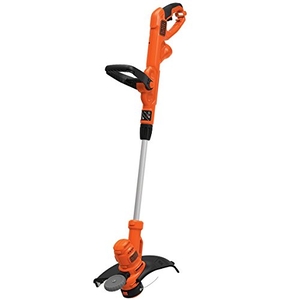
BLACK+DECKER BESTA510
Take on tough weeds, grass, and overgrowth with this BLACK+DECKER 6.5 Amp 14-inch AFS Electric Edge Trimmer.
The BLACK+DECKER BESTA510 weed eater is stocked with lots of extra features, including:
- An automatic feed spool system that provides new trimmer line as you go, so you can trim hassle-free
- A wheeled edge guide so you can make your walkways and flower beds look crisp and pristine
- A corded retention system to prevent accidental cord disconnection
Specifications:
- Weight: 5.3 lbs
- Cutting Swath: 14 inches
- Line Diameter: 0.065 inches
- Revolutions Per Minute: 8000 rpm
Pros:
✓ Lightweight design
✓ 14-inch cutting swatch
✓ Affordable
✓ Automatic feed spool system releases trimmer line as you go
✓ Wheeled edge guide
✓ Corded retention system prevents accidental cord disconnection
Cons:
✗ Some users report the automatic feed system eats through line too fast
✗ Tall users describe this weed eater as too short and uncomfortable to operate
2. BLACK+DECKER GH900
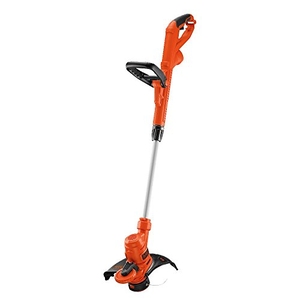
BLACK+DECKER GH900
Lightweight and ergonomic, this electric edge trimmer can take on even the tough weeds, grass, and overgrowth. This BLACK+DECKER trimmer can easily convert from trimmer to edger.
The BLACK+DECKER GH900 and BLACK+DECKER BESTA510 are similar in design, though you might find one more appealing than the other upon further research.
The BLACK+DECKER GH900 features a lightweight ergonomic design, wheeled edge guide, adjustable height, and pivoting handle.
The automatic feed system makes this tool great for beginners. And the cord retention system helps prevent nuisance cord disconnection.
Users report this 6.5 amp weed eater offers a great bang for the buck and is excellent for their small yards.
Specifications:
- Weight: 5.5 lbs
- Cutting Swath: 14 inches
- Line Diameter: 0.065 inches
- Revolutions Per Minute: 8000 rpm
Pros:
✓ 14-inch cutting path
✓ Lightweight, ergonomic design
✓ Affordable
✓ Wheeled edge guide
✓ Adjustable height and handle
✓ Automatic spool feed system
✓ Cord retention system helps prevent cord disconnection
✓ Users remark the tool offers excellent power for the low cost
Cons:
✗ Some users report their BLACK+DECKER GH900 eats through line too quickly
3. Remington RM115ST
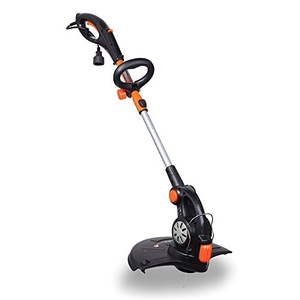
Remington RM115ST
The Remington RMT115ST is designed for trimming grass and weeds along fences, driveways and flower beds.
The Remington RM115ST weed eater is a great choice if you’re shopping on a budget but still want high performance. This Remington is the most affordable weed eater on our list, and users praise its value for the money.
The Remington RM115ST features an automatic spool feed system, 180-degree rotating handle for user comfort, and an edging wheel for enhanced precision. The shaft is also adjustable and can be lengthened for taller users or collapsed for easy storage.
Specifications:
- Weight: 7 lbs
- Cutting Swath: 14 inches
- Line Diameter: 0.065 inches
- Revolutions Per Minute: 7000 rpm
Pros:
✓ 180-degree rotating handle
✓ 14-inch cutting path
✓ Edging wheel guide
✓ Adjustable shaft
✓ Most affordable weed eater on our list
✓ Users report the tool offers good value for the money
Cons:
✗ Low rpm
✗ Heaviest corded-electric model on our list
✗ Users say the automatic feed system doesn’t feed enough line
SEE RELATED: Best Electric Weed Eaters (Reviews)
Buyers Guide
Have a few weed eaters piqued your interest? Let’s narrow down your list by reviewing different factors that go into designing a good weed eater, such as weight, power source, and the trimmer line system. You might find that some features are more important to you than others.
Power source
When shopping for your new weed eater, you’ll have your pick between gas, corded-electric, and battery-powered tools. But which one is the best power source for you? Let’s take a look at their pros and cons:
Gas
Pros:
✓ Most gas-powered weed eaters outperform battery and corded-electric models. The increased power means gas models can often cut weeds faster and handle tougher jobs.
✓ Not restricted to a battery’s limited run time
✓ You aren’t restricted to working near an outlet. You can operate your weed eater nearly anywhere in the yard.
Cons:
✗ Gas models are typically more expensive than battery and corded-electric weed eaters
✗ Gas-powered tools are not eco-friendly. They emit exhaust fumes that are harmful to the user and the environment.
✗ Gas models are usually heavy, leading to increased muscle fatigue.
✗ Working with oil and gas can be messy and smelly.
✗ Gas weed eaters are louder than corded-electric and battery-powered weed eaters
Corded-electric
Pros:
✓ Eco-friendly alternative to gas weed eaters
✓ Unlimited run time (as long as the tool doesn’t overheat)
✓ Typically lighter in weight than gas models
✓ More affordable than battery and gas-powered weed eaters
✓ Quieter than most gas models
Cons:
✗ Not as powerful as most gas models
✗ You are restricted to working near an outlet
✗ You can go only as far as the extension cord
Battery
Pros:
✓ Eco-friendly alternative to gas weed eaters
✓ Not restricted to working near an outlet. Can operate your weed eater nearly anywhere in the yard.
✓ Typically lighter in weight than gas models
✓ More affordable than gas models, though not always. Some battery-powered weed eaters are expensive.
✓ Some batteries are compatible with other tools by the same brand.
✓ Quieter than most gas models
Cons:
✗ Not as powerful as most gas models, though some high-performing battery string trimmers can be as powerful as some lower-performing gas models.
✗ Limited run time. Work can be interrupted by a dead battery.
✗ Batteries and chargers can be expensive to replace (if needed)
Curved vs. straight shaft
A weed eater’s shaft shape can have a significant effect on power and performance. There are benefits to both a curved and straight shaft, so the one you choose will simply come down to what works best for you.
A curved weed eater shaft is usually bent halfway between the cutting head and the handle. These shafts are often easier to control than straight shafts and can trim better in tight areas. If it’s your first time using a weed eater, you might like the ease and control a curved shaft has to offer.
If cutting power is what you need, then you might prefer a straight shaft. A straight shaft is commonly used in heavy-duty projects, outperforming most curved shaft models. It’s typically more comfortable for tall users to operate and it has better access under obstacles, like benches or decks. Straight shafts also tend to be more durable than curved shafts.
Versatility
Many string trimmers can convert into various tools. Some can turn into edgers with the click of a button, while others are compatible with multiple tool attachments. These attachments can convert your weed eater into other tools, including leaf blowers, pole saws, and cultivators.
If you’re looking for multiple tools in one, keep your eyes peeled for these versatile weed eater designs.
String trimmer line
A weed eater’s power won’t do much good if it’s cutting with the wrong trimmer line. And you certainly won’t have an easy job if you’re unhappy with how the string is being fed to you.
Let’s take a look at three important aspects to consider when shopping for your weed eater and its string.
What string diameter can the weed eater handle?
Some string trimmer lines are thicker than others, but not every weed eater can handle a thick string. Avoid using a string line that’s thicker than what the manufacturer recommends. Otherwise, the string might be too heavy, making the weed eater less powerful.
So what kind of string line diameter should you be looking for? If you only need to cut regular grass, a weed eater compatible with at least a 0.065-inch to 0.080-inch thick string will get the job done without a hitch.
For thick grass and weeds, your trimmer should be able to spin a 0.080-inch to 0.110-inch thick line. The best string trimmers for heavy-duty jobs are compatible with 0.110-inch thick strings or more.
What shaped string should you buy?
When adding a trimmer line to your shopping cart, you might want to consider a line shaped with an edge.
Rounded string trimmer lines might be common on store shelves, but instead of actually cutting the grass, they rip the grass. For a lawn you’re trying to keep healthy and green, ripping the grass blades is counterproductive.
String lines with a sharp edge cut your grass, and are much healthier for your turf. Lines to look out for include square or star-shaped trimmer lines.
What feeder system do you prefer?
As you trim the tall grass and weeds in your lawn, the trimmer line will eventually wear down. Here are four common ways weed eaters advance new trimmer line:
- Automatic feed systems
- Bump feed systems
- Command feed systems
- Fixed line heads
Automatic feed system: An automatic feed system releases more trimmer string when it detects the current string is running short. This feeder system has its benefits, as you needn’t pause your work to bump the trimmer head or add new string by hand.
There can be drawbacks to an automatic feed system, though. Sometimes, an automatic feed system releases too much string at a time, resulting in wasted string. The operator doesn’t have full control over when or much string is released.
Bump feed system: A bump feed system requires the operator to bump the trimmer’s head on the ground to release more string. This system gives the user more control over when they would like the string released.
The downsides? Repeated bumping of the trimmer head can lead to damages over time. And if you’re using the trimmer as an edger, bumping the trimmer head can be difficult.
Command feed systems: Like bump feed systems, command feed systems also give you more control. When the line is running low, you simply click a button or turn a dial to release more string.
Fixed line heads: Fixed line heads require an individual piece of string to be loaded as needed. These fixed line heads are ideal for commercial trimmers that use a tough, thick string that outlasts thin trimmer lines. Using a thin trimmer line on a fixed line head will lead to too many interruptions.
Dual vs. single-line
You’ll notice that string trimmers have either a dual-line head or a single-line head. Dual-line heads trim faster than single-line heads because they cut twice with each revolution. On the other hand, single-line heads are easier to wind.
Weight
If a weed eater is too heavy, it can quickly wear you out and slow down your progress. You can avoid tired muscles by shopping for a lightweight weed eater.
Height
Your height can affect how comfortable a weed eater is to operate. A short weed eater won’t be comfortable for tall operators (you may need to bend your knees or slouch your shoulders to accommodate). A long, straight shaft weed eater might not be easy to control if you are short.
When shopping for your weed eater at a local home improvement store, be sure to hold the weed eater if you can. Holding the weed eater will give you a sense of whether its length is suitable for your height. Keep in mind that some weed eater shafts are adjustable.
FAQs About Weed Eaters
Refilling the string trimmer line will vary depending on the type of weed eater model you have. Refer to your owner’s manual on how to refill the trimmer line.
This instructional video by ehowgarden provides a good example of what refilling a string trimmer line looks like on a basic feeder system.
Edging with a weed eater takes a bit of practice, so start testing your edging skills in the backyard before you edge the front yard. Starting in the back ensures your mistakes are well hidden.
Once you feel confident edging with a weed eater, try it out in the front yard.
Check out this video by Silver Cymbal for helpful tips on how to use your weed wacker as an edger.
When to Call a Professional
Another way homeowners can tackle those pesky weeds and overgrown brush is by hiring a professional for the job. If you’re not comfortable operating a weed whacker, or simply want to spend the weekend with loved ones, call a local lawn care professional to take the chore off your to-do list.
And a lawn care professional can do much more than run a weed eater across your turf –– he or she can also mow your lawn, rake the leaves, and even apply fertilizer. So kick back, relax, put that weed eater back on the shelf, and finally get back to enjoying your lawn (instead of breaking your back over it).
Main Image Credit: eleonimages / Canva Pro / License wih Text Overlay using Canva Pro
LawnStarter participates in the Amazon Services LLC Associates Program and other retailer affiliate programs. LawnStarter may earn revenue from products promoted in this article.